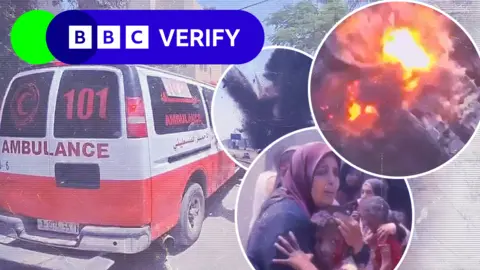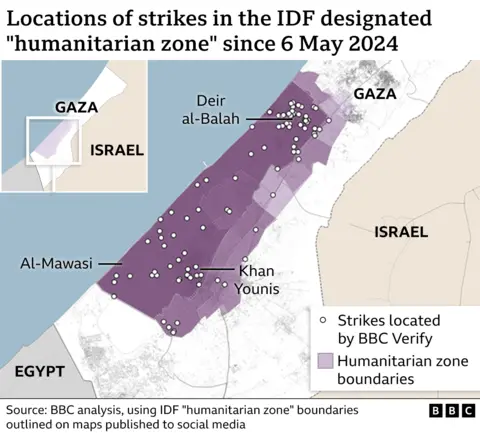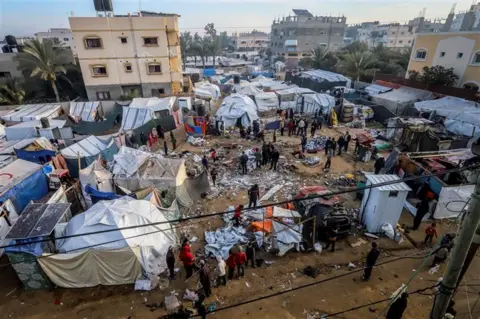 BBC
BBCThe area of Gaza where the Israeli army has asked people to go “for their safety” has been hit by 97 strikes since May, a BBC Verify analysis has revealed.
These conclusions come as negotiations for a ceasefire between Israel and Hamas appear to be on the verge of success. Mediators in Qatar say talks are in their final stages, raising hopes a deal could be reached soon.
The “humanitarian zone” was first created by the Israel Defense Forces (IDF) in October 2023 for the “humanitarian zone”.protection” residents to “protect innocent civilians from danger”.
On May 6, 2024, the IDF significantly expanded the area to include the towns of Khan Younis and Deir al-Balah.
The area – much of which is a strip of land along the Mediterranean Sea – is densely populated and more than a million people are estimated to live there according to international humanitarian organizations. Many people live in tents, with limited infrastructure and limited access to aid.
In a statement to BBC Verify, the Israeli military said it was targeting Hamas fighters operating in the “humanitarian zone” and accused the group of violating international law by “exploiting” civilians as human shields and launching rockets from the area.

Israel launched a campaign to destroy Hamas in response to the group’s October 7, 2023 attack, in which around 1,200 people were killed and another 251 taken hostage.
The conflict has caused significant damage to infrastructure across Gaza, with satellite images showing areas razed by Israeli strikes. The Hamas-run Health Ministry also says more than 46,600 people have been killed in the enclave since the war began.
BBC Verify analysis suggests attacks within the “humanitarian zone” have intensified since May 2024, with at least 22 strikes already recorded so far this month.
Local media reports say more than 550 people were killed in the 97 strikes mapped by BBC Verify.
BBC Verify cannot confirm that all incidents are the result of IDF attacks. Israeli military officials have publicly acknowledged 28 attacks since May 6, but have not confirmed their involvement in the other attacks documented by BBC Verify.
Gavin Kelleher, head of Gaza access for the Norwegian Refugee Council (NRC), said there were “almost daily” strikes in the area, including from Israeli ships and quadcopters, or small drones.
He added that “heavy fire is recurrent in this area despite its (Israel’s) unilateral designation as ‘humanitarian’.”
“The Israeli army seems to want to maintain the illusion of a humanitarian zone which remains of a certain size, but this zone can be subject to “evacuation orders” at any time and be targeted,” Mr. Kelleher said.
A resident who lives in the area, Khaled Abdel Rahman, told the BBC that residents were subjected to daily shelling, frequently resulting in injuries and casualties.
“We were moved to Khan Younis because it was designated as a safe zone, but in reality we find nothing there but insecurity,” Mr. Rahman said. “We have been denied a true sense of security, with fear dominating our lives.”
As Israel does not allow foreign journalists to access Gaza – apart from the highly controlled and escorted trips of its soldiers, the international media, including the BBC, rely on images collected by Palestinian journalists and residents of Gaza.
To track attacks in the IDF’s “humanitarian zone,” BBC Verify monitored Palestinian social media and official IDF channels on Instagram, Telegram and the area were then cross-referenced with local information. media reports to determine the number of reported deaths.
It is important to note that the death toll cannot be verified based on videos and social media reports alone. BBC Verify’s analysis excluded reports of deaths where there was no verifiable footage confirming that the incident occurred within the IDF-defined boundaries of the “humanitarian zone.”
BBC Verify examined more than 300 videos and photos posted since May in the “humanitarian zone”. Although it is not always possible to distinguish between combatants and civilians, the images show dozens of people, including women and children, pulled from the rubble. Some appeared lifeless, while others were badly burned or had significant injuries to their limbs, alongside collapsed buildings, destroyed tents and burned cars.
 Saeed Jaras/AFP via Getty Images
Saeed Jaras/AFP via Getty ImagesSeven of the documented strikes each reportedly killed 20 or more people, with the deadliest occurring on July 13, more than 90 deathsaccording to the Gaza Ministry of Health, first responders and doctors.
The Israeli military later said Mohammed Deif, military leader of Hamaswas among the dead. Deif is accused of being one of those responsible for planning the October 7 attacks.
Nine strikes took place within 100 meters of buildings belonging to Al-Aqsa Hospital in Deir al-Balah, and four within 150 meters of the hospital. Nasser Medical Complex in Khan Younes.
The Israeli military told BBC Verify that the strikes were carried out “against terrorists and terrorist infrastructure, including rocket launchers, warehouses and weapons manufacturing sites, operational apartments, underground infrastructure, operational headquarters and terrorist hideouts.”
They also included links to six of their previously published statements on Hamas fighters operating in the “humanitarian zone.”
Residents of the area also live in constant uncertainty. Including evacuation notices, the boundary of the “humanitarian zone” has changed 20 times – and its size has varied from approximately 7 km² (2.7 square miles) when first introduced to 72 km² (27.8 square miles) at its largest size. .
The Israeli military said the evacuation notices “do not constitute a reduction of the humanitarian zone. Once the danger has passed, residents return.” But it’s unclear how residents know it’s safe to return, and the Israeli military has only made two social media posts to explicitly say so. BBC Verify did not include strikes inside areas where evacuation notices were issued in our count.
Although the Israeli military has avoided using the term “safe zone”, its statements have led civilians to interpret the “humanitarian zone” as such. IDF evacuation notices include language telling civilians: like this one which was published in mid-December – “for your own safety, immediately move west towards the humanitarian zone.”
He also described the area as “designated for humanitarian assistance and shelters as part of the IDF’s ongoing efforts to protect the uninvolved population.”
But the UN and international humanitarian organizations operating in Gaza I said there was no “safe zone” which is applied unilaterally.
Juliette Touma, of the UN Palestinian refugee agency Unrwa, said: “We have said it many times. There is no safe zone in Gaza. No place is safe. No one is safe. No place is safe.”
Additional reporting by Paul Brown.




